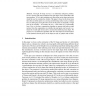149
click to vote
AMFG
2005
IEEE
15 years 2 months ago
2005
IEEE
Non-rigid 3D shape recovery is an inherently ambiguous problem. Given a specific rigid motion, different non-rigid shapes can be found that fit the measurements. To solve this am...
109
Voted
AMDO
2008
Springer
15 years 2 months ago
2008
Springer
We present a system that can segment articulated, non-rigid motion without a priori knowledge of the number of clusters present in the analyzed scenario. We combine existing algori...
BMVC
2001
15 years 2 months ago
2001
We address the problem of non-rigid motion and correspondence estimation in 3D images in the absense of prior domain information. A generic framework is utilized in which a soluti...
110
Voted
IBPRIA
2007
Springer
15 years 6 months ago
2007
Springer
This paper presents a method to efficiently estimate average 3-D shapes from non-rigid motion in the case of missing data. Such a shape can be further used to accomplish full reco...
105
click to vote
ICRA
2007
IEEE
15 years 6 months ago
2007
IEEE
— Most robotic vision algorithms are proposed by envisaging robots operating in structured environments where the world is assumed to be rigid. These algorithms fail to provide o...
123
Voted
ICPR
2002
IEEE
16 years 1 months ago
2002
IEEE
* We present a novel approach for grouping from motion, based on a 4-D Tensor Voting computational framework. From sparse point tokens in two frames we recover the dense velocity f...
103
Voted
ICIP
2007
IEEE
16 years 2 months ago
2007
IEEE
We present our system for the capturing and analysis of 3D facial motion. A high speed camera is used as capture unit in combination with two surface mirrors. The mirrors provide ...
109
click to vote
ICCV
2003
IEEE
16 years 2 months ago
2003
IEEE
Within this paper a new framework for Bayesian tracking is presented, which approximates the posterior distribution at multiple resolutions. We propose a tree-based representation...

